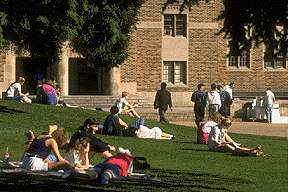
1. In the fall of 1995, the average high school GPA for entering freshmen was 3.6 and the average combined SAT was 1085. What was the minimum GPA and SAT for a resident student to be considered for regular admissions?
Being a day student in Seattle is no longer the only way to earn a UW degree. To look at the choices, Columns asked Director of Admissions W.W. "Tim" Washburn and Associate Admissions Director John Swiney 10 questions on options for today's students.

1. In the fall
of 1995, the average high school GPA for entering freshmen was 3.6 and
the average combined SAT was 1085. What was the minimum GPA and SAT for
a resident student to be considered for regular admissions?
We have an index which is based on both your high school GPA and your combined SAT scores, so it depends. Let's say you had the national average for the SATs, which was 900 last year and is 1000 this year. To be considered for admission for fall of 1995, high school seniors with these scores needed at least a 3.1 GPA. Students at that level were reviewed closely to evaluate such factors as the rigor of the high school curriculum, the number of honors or advanced placement courses taken, grade trends and other considerations. Last fall roughly 1,000 resident applicants got this expanded review and 61 percent were offered admission.
2. How much do you weigh the GPA versus the SAT score?
We weigh the high school GPA at 75 percent and the SAT score at 25 percent in creating our academic index.
3. My son goes to a rigorous private high school. On paper his GPA looks lower than other students, but I know that he is a top scholar. Don't you consider where these grades are coming from?
Yes, but the list of public and private schools eligible for adjustment is pretty small. We have an adjustment factor based on how well other students from these rigorous schools have done once they are at the UW. For example, a 3.1 from one of these schools might be adjusted up to a 3.4 GPA.
4. Does it help my daughter that one parent is an alumnus of the UW?
If you are non-residents, yes, it helps. To be admitted, your non-resident daughter only has to meet the in-state academic requirements, not the much higher non-resident standards. She will still have to pay non-resident tuition, however. For Washington state residents, it is not a factor.
5. It doesn't look like my child will get into the UW as a freshman. Are there any alternatives that can still result in a UW degree?
Yes, your child can transfer to the UW after attending another college. Many people are surprised to learn that more than half our undergraduate degrees are awarded to students who switched to the UW from another college.
There are two ways to transfer. Many students are admitted competitively, based on their test scores and/or the grades they have received from another institution. On average, resident transfers now need at least a 3.2 college GPA to get in.
The other alternative is through the Direct Transfer Agreement with state community colleges. Washington residents who have completed an associate degree at a state community college and achieve at least a 2.75 GPA are automatically admitted. You might not always get to come the first quarter you want, but there will be space for you eventually.
6. What about the branches?
The UW-Bothell and UW-Tacoma campuses are an excellent alternative to the daytime offerings in Seattle. Both offer junior- and senior-level courses leading to a B.A. Each has several graduate degree programs as well. While their academic standards are high, it is easier to transfer into the branches. Their admissions offices can be more flexible because there are more spaces available.
7. Any other options for a UW degree?
The UW offers 10 undergraduate and six graduate-level degree programs in the evening. In addition, an evening degree program for M.B.A.s starts in September. Currently, the undergraduate programs begin with junior-level courses. Depending on the degree you want and the demand, you might find it easier to transfer into the evening degree program than into the daytime program.
8. Aren't a lot of out-of-state students taking up space that my son and daughter could have instead?
No. In 1995, the UW enrolled only 559 non-residents in its freshman class of 3,701. For undergraduates, non-residents total 2,516 out of 24,904, which is only 10 percent. Many of our peers have a much higher non-resident rate, such as Oregon with 40 percent or Michigan with 41 percent.
9. My child didn't get into the UW. Is there an appeal process?
We don't encourage appeals, but yes, there are steps you can take. A faculty committee meets to review the files of those who petition for "special consideration." There are no forms to fill out. You write a letter to the committee that we forward along with the file. Out of hundreds of appeals each year, perhaps a third are granted. Fewer freshman petitions are approved, however, since the "older but wiser" cases are more convincing. The committee has complete discretion and considers personal hardships and disabilities.
10. What is the current tuition and what do you predict for the future?
Currently in-state undergraduates pay $3,019 annually and non-residents pay $8,523. There is no question that tuition will rise over the coming years. Since 1990 resident tuition has risen 55 percent. By the way, the UW does not set tuition. The Legislature determines tuition rates when it writes its two-year budgets.
For more information on attending the UW, visit The UW Bulletin—A Guide for Freshman, Transfer or Graduate Students. [Editor's note, November 2000: The UW has reorganized its information for prospective students. Check the Student Guide for more information.]
Send a letter to the editor to columns@u.washington.edu.